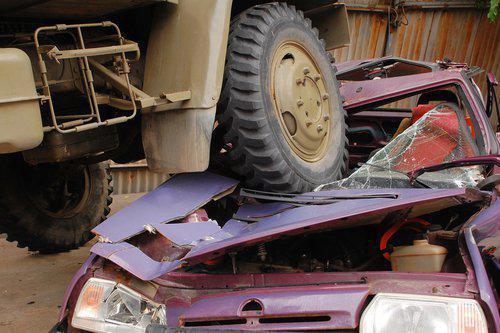Recent Blog Posts
Fun the Water - Five Tips for Safe Boating in Wisconsin
Summer heat means fun on the many lakes and waterways in Wisconsin. While boating can equal family fun and great memories, it can also result in serious boating accident if you are not careful. The following article offers five things you should know before you head out on the lakes.
1. Age Requirements - Children under the age of 10 may not operate a boat under any circumstances. Children who are 10 or 11 may do so only if they are accompanied by a parent, guardian or adult 18 or older who is designated as a guardian. If a child ages 12-15 has completed a Wisconsin DNR boater's safety course they may operate a boat alone, otherwise a parent or guardian must be on board. Minors 16 to 18 must complete a boater's safety course.
2. Unlawful Operation of a Boat -The Wisconsin DNR states that the following operating practices are dangerous and illegal.
Summer Campfires - Proceed with Caution
Outdoor summer fun often revolves arounds spending quality time around a campfire, telling stories and singing songs. However this fun family past time is also one of the most dangerous parts of the summer months.
Bonfire or campfire accidents are the among most common cause injuries involving fire. Often, these types of accidents occur when children or young people are grilling s'mores or hot dogs over a campfire and they get too close to the fire. Other times, they may be sitting at a reasonable or safe distance from the fire, and someone dangerously throws some sort of accelerant on to the fire to create a large "boom" or maintain or increase the burn. These injuries might also occur when people are burning yard waste, branches or grass clippings on their own property.
Children's Hospital of Wisconsin states that 74% of camping injuries are caused by campfires. Furthermore, it notes that approximately 50% of those admitted to the hospital from these type of accidents are less than 4 years old. What this means is that people need to take special care with young children and campfires or bonfires.
Don't Get Burned-5 Things to Know About Fireworks in Wisconsin
 By Attorney Steven McGaver
By Attorney Steven McGaver
The Fourth of July is right around the corner, and fireworks stores across Wisconsin are gearing up for their busiest seasons. Before you buy your share of explosives, make sure you read these tips to make sure that your Fourth of July display isn't ruined by blue and red lights.
1. You don't need a permit to possess some types of fireworks - Wisconsin law allows the sale, possession and use of sparklers less than 36 inches long, stationary cones and fountains, toy snakes, smoke bombs, caps, noisemakers, confetti poppers with less than 1/4 grain of explosive mixture, and novelty devices that spin or move on the ground without any type of state permit. (Wis. Stat. §167.10(1). There is no age restriction on sale, possession or use of these devices, mainly because the law does not classify them as fireworks. Remember to check your local ordinances, as they may be more restrictive than state statutes and may prohibit any of these items or limit their sale or use.
Truck Driver Fatigue Accidents: Increased Safety Threat on the Road
 The U.S. Department of Transportation reports that over 300,000 large trucks were involved in collisions in 2012 with 104,000 people injured as a result. This number of injuries was an 18 percent increase from the previous year. Injuries resulting from a truck driver fatigue accident can range from bruising and aggravated pain to severe injuries such as broken bones, and in certain instances, fatality. Safety on the road is the responsibility of every driver.
The U.S. Department of Transportation reports that over 300,000 large trucks were involved in collisions in 2012 with 104,000 people injured as a result. This number of injuries was an 18 percent increase from the previous year. Injuries resulting from a truck driver fatigue accident can range from bruising and aggravated pain to severe injuries such as broken bones, and in certain instances, fatality. Safety on the road is the responsibility of every driver.
Traffic accidents involving commercial trucks typically occur as a result of one of the following:
- Poor driver performance;
- Violation of safety regulations;
- Distracted driving;
- Vehicle malfunction;
- Driver fatigue.
The Discovery Process in Personal Injury Cases
 Many people have a mistaken belief that much of a lawyer's job is done during the trial, examining witnesses, talking to the jury, and convincing the judge that their side is right. While these skills are certainly important, focusing on them ignores all the groundwork that goes into a case before trial, and it ignores the fact that over 90 percent of cases settle without ever getting to a trial.
Many people have a mistaken belief that much of a lawyer's job is done during the trial, examining witnesses, talking to the jury, and convincing the judge that their side is right. While these skills are certainly important, focusing on them ignores all the groundwork that goes into a case before trial, and it ignores the fact that over 90 percent of cases settle without ever getting to a trial.
In fact, much of the work a lawyer does happens before the trial ever starts during the “discovery phase” of the lawsuit. During this phase the lawyers exchange information with each other to help both sides build the best case. This lets lawyers go into a trial in a way that avoids any surprises, and allows them to orchestrate the best case possible. This can be especially important in personal injury cases where one side often has much more information on what happened than the other.
Bad Weather and Traffic Accident Liability
 Winter is coming, which means that inclement weather is on the way. According to the Federal Highway Administration, it also means a spike in traffic accidents. While Wisconsin drivers are familiar with driving in ice and snow, they may not be so familiar with the legal ramifications for it, particularly if there is an accident. Although many drivers are content to blame the increase in accidents during bad weather on the weather itself, the law is not so forgiving. Courts still often assign fault to one of the drivers in these traffic accidents, so it is important for drivers to understand their duties in bad weather.
Winter is coming, which means that inclement weather is on the way. According to the Federal Highway Administration, it also means a spike in traffic accidents. While Wisconsin drivers are familiar with driving in ice and snow, they may not be so familiar with the legal ramifications for it, particularly if there is an accident. Although many drivers are content to blame the increase in accidents during bad weather on the weather itself, the law is not so forgiving. Courts still often assign fault to one of the drivers in these traffic accidents, so it is important for drivers to understand their duties in bad weather.
Traffic Accidents during Bad Weather
The issue that many drivers face in bad weather is that they do not understand the difference between speeding and “excessive speed.” Speeding is a traffic violation that involves going faster than the posted speed limits. Those speed limits were designed with dry, clear weather in mind, so it is entirely possible to be going the speed limit and still be going too fast under the law.
Bike Accident Injuries in Wisconsin
 Bicycles have become increasingly popular over the past decade as the cost of gas has risen and people have taken a more active interest in the health of the environment. In fact, according to statistics published by a bicycle industry magazine, bike sales have increased more than five percent over the past three years alone. While this increase in biking may be good for the planet, it can also pose a serious risk to pedestrians. Many pedestrians are not as careful watching for bikes as they are with cars, but bicycle-pedestrian collisions can still cause serious injuries. With more cyclists on the roads and sidewalks, it can be important for pedestrians to understand the dangers and know how to react.
Bicycles have become increasingly popular over the past decade as the cost of gas has risen and people have taken a more active interest in the health of the environment. In fact, according to statistics published by a bicycle industry magazine, bike sales have increased more than five percent over the past three years alone. While this increase in biking may be good for the planet, it can also pose a serious risk to pedestrians. Many pedestrians are not as careful watching for bikes as they are with cars, but bicycle-pedestrian collisions can still cause serious injuries. With more cyclists on the roads and sidewalks, it can be important for pedestrians to understand the dangers and know how to react.
Bike Accident Injuries
ATV and Snowmobile Accidents
 Wisconsin has a large amount of open land, perfect for riding ATVs on, and with winter approaching, it will soon become time for people to start breaking out their snowmobiles as well. While these vehicles can be fun for experienced, responsible riders, they also pose a danger. According to statistics compiled by the Wisconsin Department of Natural Resources, dozens of people each year die related to ATV and snowmobile accidents. It is important to understand that these vehicles are very different from cars, which means that the causes of ATV and snowmobile accidents, injuries, and litigation surrounding injuries is different from an ordinary traffic accident.
Wisconsin has a large amount of open land, perfect for riding ATVs on, and with winter approaching, it will soon become time for people to start breaking out their snowmobiles as well. While these vehicles can be fun for experienced, responsible riders, they also pose a danger. According to statistics compiled by the Wisconsin Department of Natural Resources, dozens of people each year die related to ATV and snowmobile accidents. It is important to understand that these vehicles are very different from cars, which means that the causes of ATV and snowmobile accidents, injuries, and litigation surrounding injuries is different from an ordinary traffic accident.
Causes of Accidents
Riders tend to take ATVs and snowmobiles off of open roads and into fields, woods or other rough terrain. This can lead to types of accidents that do not occur often with more mundane vehicles. For instance, 45 percent of ATV and UTV fatalities last year occurred when a vehicle rolled over on top of its rider. While rollovers do happen with cars, they are not nearly so common or so deadly. The combination of less experienced riders, more treacherous terrain, and fewer safety precautions like roofs and roll bars make rollovers more dangerous in these sorts of vehicles.
Deer Collisions and Car Crashes
 Deer collisions are a common problem for Wisconsin drivers, but it pays to be extra vigilant during the end of the year since it is their mating season, the time when deer are most active. In fact, according to the Wisconsin Department of Transportation's statistics, there are over 18,000 deer collisions in Wisconsin every year, making it a high-risk state for deer collisions. Deer collisions can be surprisingly dangerous because of a combination of their large size and sharp antlers. Especially important is the fact that deer can even be responsible for crashes between two cars. Given these dangers, drivers should learn how to minimize their risk of deer collision and what to do if they are involved in one.
Deer collisions are a common problem for Wisconsin drivers, but it pays to be extra vigilant during the end of the year since it is their mating season, the time when deer are most active. In fact, according to the Wisconsin Department of Transportation's statistics, there are over 18,000 deer collisions in Wisconsin every year, making it a high-risk state for deer collisions. Deer collisions can be surprisingly dangerous because of a combination of their large size and sharp antlers. Especially important is the fact that deer can even be responsible for crashes between two cars. Given these dangers, drivers should learn how to minimize their risk of deer collision and what to do if they are involved in one.
Tips for Handling Deer Crashes
The optimal way to handle a deer collision is to avoid it in the first place. While some accidents are unavoidable, drivers do have strategies available to them if they want to make the collision less likely. For instance, deer tend to be the most mobile during the evening hours, so extra vigilance during those hours can help, especially in dark or forested areas or in areas with signs posted about the presence of deer. Similarly, the use of extra bright headlights in dark, low-traffic areas may help to make deer more visible. If a driver does spot one deer, then he or she should also keep in mind that deer are herd animals, so it is likely there are others roaming around in the area.
What Makes Truck Accident Cases Different?
 Any traffic accident has the potential to cause death or serious injury, but truck accidents can be especially problematic. A truck’s sheer size and weight can mean that truck accidents are especially likely to result in fatalities. In fact, according to statistics compiled by the National Highway Traffic Safety Administration, large trucks represented only four percent of vehicles on the road, but they were involved in eight percent of fatal accidents.
Any traffic accident has the potential to cause death or serious injury, but truck accidents can be especially problematic. A truck’s sheer size and weight can mean that truck accidents are especially likely to result in fatalities. In fact, according to statistics compiled by the National Highway Traffic Safety Administration, large trucks represented only four percent of vehicles on the road, but they were involved in eight percent of fatal accidents.
There are a host of factors that make truck accident lawsuits different than lawsuits about ordinary traffic accidents, however many of them stem from two causes. First, truck drivers are professionals, which mean that they have different regulations and legal duties. Second, collecting and managing evidence in cases with large truck accidents is very different.









